What are Revenue Operations?
Over the past 5-10 years, a type of position imported from the US tech ecosystem has increasingly appeared in France: the”ops”.
Often preceded by the name of the business they support (sales ops, customer ops, customer ops, support ops, finance ops,...) or by a more general term (Business Ops, Revenue Ops), what is the role of these teams in reality?
What are Revenue Operations?
Les Revenue Operations cover all the activities that support the proper functioning of the various departments of a company. Unlike teams that are in direct contact with customers (sales, customer service, marketing), RevOps work behind the scenes to ensure that these teams function optimally. They play a role in optimizing processes, managing tools, and facilitating collaboration between different departments.
Their main objective is to ensure that each department has the resources, data, and tools they need to achieve their goals. It also involves setting up systems to measure performance and propose adjustments if necessary.
The key missions of Revenue Operations
1. Continuous process improvement
The teams RevOps are responsible for identifying inefficiencies in internal processes and resolving them. Whether by automating manual tasks, integrating new tools, or completely rethinking certain steps, their goal is to increase productivity and minimize bottlenecks.
Examples of typical “process” missions:
- Redesign of a process of prospecting, sales, onboarding, onboarding, customer follow-up, ticket management, support, customer churn...
- Operational variation of a team reorganization
- “Post merger integration”: analysis and integration of the processes of 2 companies in the context of a company takeover...
2. Management of tools and technologies
A large part of the role of RevOps consists in selecting, deploying and managing the technological tools used by the various teams. This can include CRMs, project management software, or data analysis platforms. They ensure that teams can use these tools effectively and that they are well integrated into the company's technology infrastructure.
Examples of typical “tool” missions:
- CRM administration, integration of CRM with other tools (VoIP, ERP, CPQ, marketing,...)
- CRM migration
- Benchmark, test and buy solutions
- License and renewal management...
3. Data analysis and decision making
Les RevOps use data to guide strategic and operational business decisions. They provide regular reports that measure the performance of the various departments and identify opportunities for improvement. By analyzing this data, they are able to propose adjustments that will have a positive impact on all operations.
Examples of typical “data” missions:
- Definition of Business plans (sales forecast, support load forecast, definition of recruitment plans)
- Preparation of the boards/CA
- Implementation of operational management: definition of KPIs, implementation of dashboards
- Ad hoc analyses: analyses necessary for decision-making for company management and leadership...
4. Cross support
One of the essential roles of RevOps is to serve as a liaison point between the various departments of the company. They ensure that sales, marketing, customer service, customer service, finance, and other teams work together seamlessly. This transversal role makes it possible to avoid silos and to ensure that information flows effectively between teams.
Examples of typical “transversal” missions:
- Project management
- Managing Business Transformations
- Alignment of teams on common goals...
Why is Revenue Operations essential?
Les Revenue Operations allow businesses to optimize all of their resources by ensuring that each department operates at maximum capacity. Through process improvement, tool optimization, and data analysis, they enable better coordination between teams and ensure that overall business goals are achieved.
In an environment that is increasingly focused on results and speed of execution, the function RevOps offers the company greater flexibility and agility. By reducing inefficiencies, they increase teams' ability to generate value while minimizing costs. In addition, their ability to analyze large volumes of data in real time allows increased reactivity in the face of market changes.
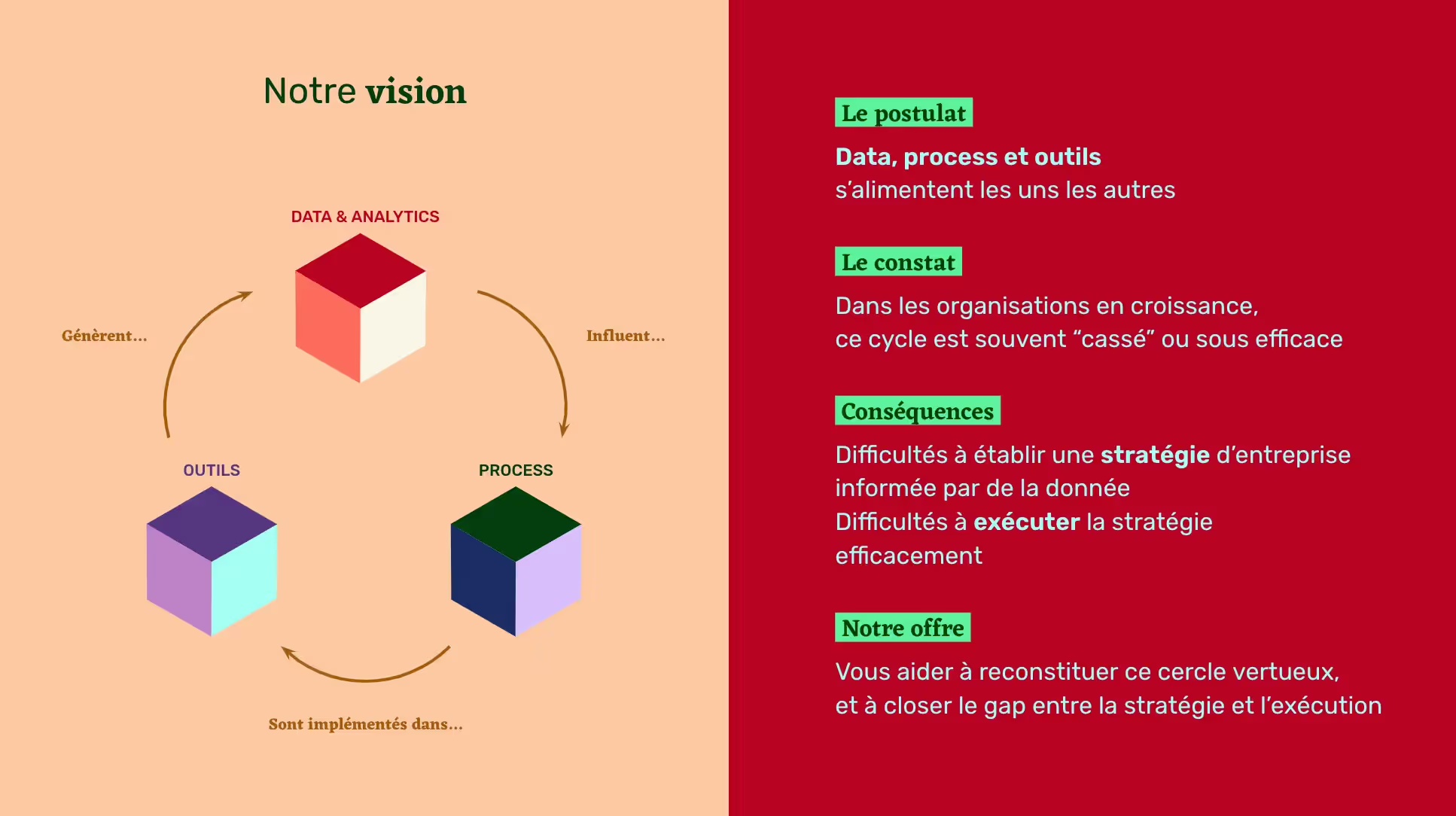
Examples of activities: Sales Ops vs Customer Ops
Although the Revenue Operations cover a wide range of functions, their two most common business variations are Sales Ops And the Customer Ops, each with specific activities:
- Sales Operations (Sales Ops) :
- Optimization of sales processes (reduction of sales cycles, pipeline management).
- Automation of repetitive tasks related to sales (sending quotes, managing leads).
- CRM management to ensure that customer and prospect data is well organized and up to date.
- Monitoring the performance of sales teams using dashboards.
- Customer Operations (Customer Ops) :
- Management of customer interactions through ticket systems to improve customer satisfaction.
- Improvement of onboarding processes to ensure a better customer experience from the start.
- Implementation of feedback systems to monitor customer needs and expectations in real time.
- Coordination of support teams to respond effectively to requests and resolve technical issues.
Les Revenue Operations are an essential function for the overall performance of the company. By managing internal processes, technological tools and relying on data analysis, they allow the company to remain competitive and agile. At the same time, specializations such as Sales Ops et les Customer Ops garantissent que les équipes de vente et de service client bénéficient d’un soutien adapté, permettant d’optimiser leurs performances et d’offrir une meilleure expérience client.
Origine des profils
Le métier étant plutôt récent en France, peu de profils ont aujourd’hui plus 5-6 ans dans le rôle, et l’ont exercé dans plusieurs entreprises. Il peut donc être compliqué pour une entreprise de recruter directement des ops ayant directement de l’expérience dans le métier, et celles-ci se tournent donc souvent vers d’autres viviers.
Les personnes recrutées sur ces postes proviennent donc principalement de 3 origines :
1. Le profil issu de la vente ou du Customer Success (ex-sales, ex-CSM)
Ce candidat a décidé de s’éloigner de l’interaction client. Désireux de s’impliquer davantage dans des projets stratégiques, il aspire à travailler sur des sujets tels que les processus internes, les plans de commissionnement, ou encore l’organisation.
Points forts :
- Expertise métier : Sa connaissance approfondie des réalités du terrain le rend capable de proposer des solutions pertinentes et réalistes. Sa proximité avec l’équipe de vente et sa crédibilité auprès d’elle facilitent l’adoption des process qu’il met en place.
Points d’attention :
- Manque de compétences techniques : Ce profil a généralement peu de connaissances en modélisation, architecture technique (SQL, CRM, etc.), ou en gestion avancée de bases de données. Il lui faudra se former sur ces sujets pour être pleinement efficace dans son nouveau rôle.
2. L’ex-consultant
Ayant travaillé pour de grandes entreprises, ce candidat a souhaité quitter les projets de longue haleine, éloignés des réalités opérationnelles, pour avoir un impact plus direct et concret.
Points forts :
- Capacité d’écoute et d’analyse : Grâce à son expérience en conseil, il excelle dans l’écoute active et la résolution de problèmes. Il sait transformer des problématiques complexes en solutions concrètes, tout en maîtrisant la gestion de projet.
Points d’attention :
- Pragmatisme opérationnel : Ces profils n’ont souvent jamais travaillé sur des tâches concrètes et peuvent être réticents à mettre la main à la pâte. Il est crucial de tester rapidement leur capacité à se confronter aux outils et processus du quotidien, car ce manque de pragmatisme pourrait devenir un frein à leur succès dans la fonction Ops.
3. Le profil financier
Issu du monde de la finance (M&A, private equity, ou finance d’entreprise), ce candidat a développé une expertise pointue dans les domaines de la modélisation et de l’analyse financière.
Points forts :
- Maîtrise des sujets financiers : Ces profils sont particulièrement efficaces pour élaborer des business plans, définir des objectifs de recrutement ou encore gérer la modélisation d’objectifs financiers à long terme.
Points d’attention :
- Adaptation aux processus et outils opérationnels : N’ayant souvent travaillé que sur des problématiques financières, ces profils peuvent avoir des difficultés à s’immerger dans la réalité opérationnelle d’une équipe. Il est essentiel de les accompagner pour les aider à se connecter au terrain et à s’adapter aux outils non financiers utilisés au quotidien.
En définitive, chacun de ces profils peut potentiellement devenir un excellent Ops, à condition de bien comprendre leurs forces et faiblesses respectives. Il est crucial d’aligner les compétences du candidat avec les besoins spécifiques de l’entreprise et d’anticiper les points d’amélioration nécessaires. Une évaluation rigoureuse en entretien, notamment par la mise en situation, permettra de vérifier la capacité d’adaptation et la compatibilité du profil avec le rôle opérationnel.
Salaires dans les équipes opérations
La principale ressource en France sur le sujet est l’étude annuelle du Business Operations Network. Elle est menée auprès de près de 400 personnes, provenant de 117 entreprises telles que Doctolib, PayFit, Swile, et BlaBlaCar.
L'expérience médiane des répondants est de 5 ans, avec 3 ans d'expérience spécifique dans les métiers Ops. Environ 60% des participants occupent des postes de senior, lead ou manager.
Salaires par niveau hiérarchique
- Managers/Team Leads : Salaire médian de 64K€, avec un maximum à 107K€. 64% bénéficient d'un bonus.
- Seniors : Salaire médian de 56K€, avec un maximum à 88K€. 56% ont un bonus.
- Juniors/Entry Level : Salaire médian de 47K€, avec un maximum à 50K€ et 61% avec un bonus.
- Directeurs/VPs : Salaire médian de 102K€, avec un maximum à 166K€. 80% bénéficient d'un bonus.
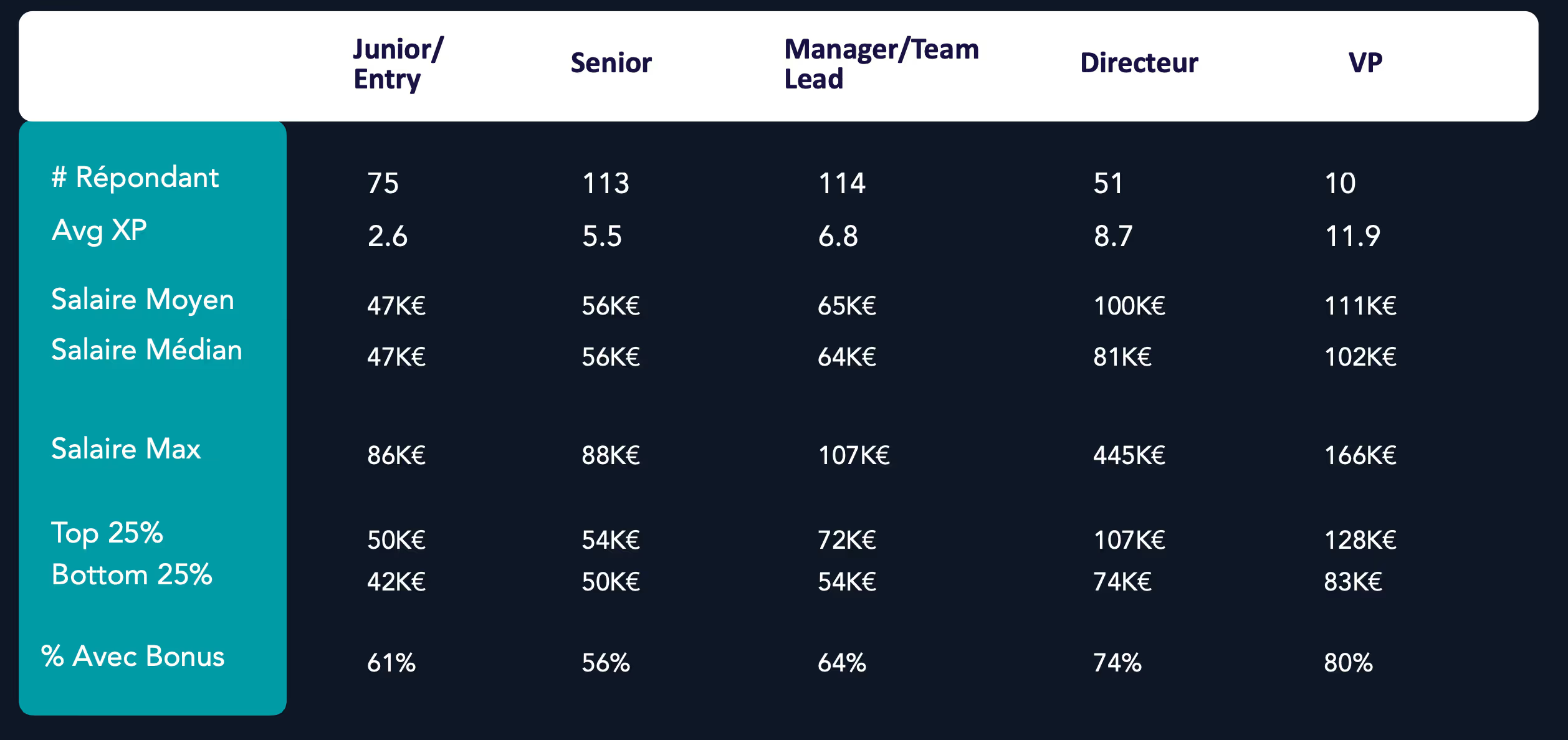
Salaires par expérience
- Pour moins de 2 ans d'expérience : 45K€ de salaire médian.
- Pour 5 à 6 ans d'expérience : 77K€ de salaire médian.
- Pour plus de 16 ans d'expérience : 99K€ de salaire médian.
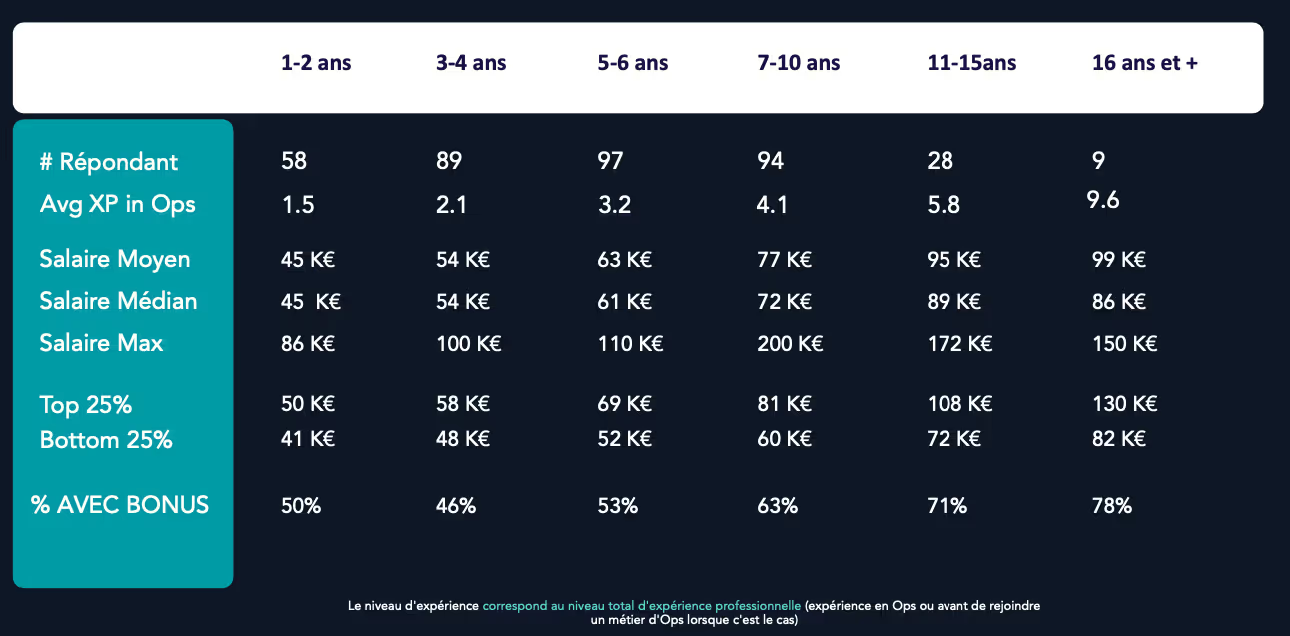
Informations supplémentaires
- La présence de responsabilités managériales entraîne généralement des salaires plus élevés, surtout à partir de 5 ans d'expérience.
- Les salaires des Ops ont augmenté en moyenne de 8% en 2023, malgré le contexte économique difficile.
- 64% des professionnels Ops bénéficient d'un mécanisme d'intéressement au capital de leur entreprise (BSPCE), particulièrement les directeurs (76%) et VP (80%).
- 55% des Ops ont une part variable dans leur rémunération, souvent basée sur la performance individuelle et/ou celle de l'entreprise.
Cette étude révèle que les métiers Ops sont en pleine croissance en termes de rémunération et de reconnaissance, avec une importance croissante du variable et de l'intéressement. Le management des équipes joue un rôle clé dans l'évolution des salaires, et les entreprises adaptent leurs politiques de rémunération pour retenir les talents.
Comment structurer une équipe opération
Dimensionnement de l’équipe
Dans les premiers moments de l’émergence de la fonction Ops au sein de l’entreprise, on observe assez souvent le ratio 1/10 entre le headcount Ops et le headcount métier (sales / customer success ou care, etc).
Cela est notamment dû au fait que cela correspond souvent à des périodes de structuration importante pour l’entreprise :
- Absence d’Ops in the past: involving a large number of needs, projects, and therefore resources
- Strong growth: involving the need to constantly reinvent oneself, and therefore bringing again a large number of structuring projects entrusted to Ops
As the business grows and is structured, the ratio Ops /profession often tends to decrease. We often observe a stabilization of this ratio at 1/20.
In any case, these benchmarks are a general rule to be adapted to each situation. Les Ops being business experts, the more they will support a large number of professions, the more the organization Ops will be substantial.
<aside>💡
Example:
For a customer service of 100 people composed as follows:
- A support team (itself divided into 3 levels): 25 people
- An onboarding team: 25 people
- A back office team: 25 people
- A success team (or account manager): 25 people
→ 4 to 5 Ops minimum, at least 1 per job
For a sales department of 100 people composed as follows:
- A prospecting team: 50 people
- A sales team: 50 people
→ 2 Ops minimum, at least 1 per job
</aside>
Hierarchical link to the team
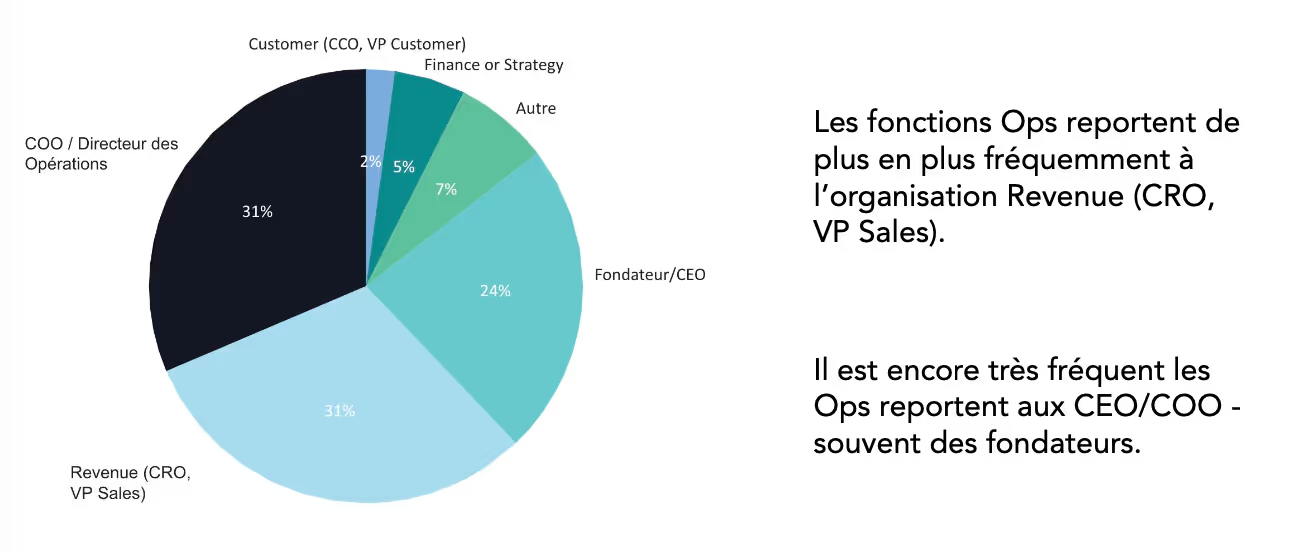
The organization must evolve to meet the needs of the business at the moment. There are often four typical phases in the evolution of an organization Ops.
Step 1: Direct reporting to business teams
In this first phase, the teams Ops, like the Sales Ops And the Customer Success Ops, report directly to business managers (Head of Sales, Head of Customer Success, etc.). These departments are generally at the origin of the need and the recruitment of these profiles. Ops.
Benefits
- Business proximity : Being directly integrated into business teams allows a better understanding of needs, responsiveness to needs, and promotes the creation of relationships of trust with teams.
Disadvantages
- Silo organization : This model creates fragmentation between different teams Ops (Sales, CS, etc.), which prevents the creation of synergies between functions that, however, share many common goals.
- Conflicts of interest : Businesses may prefer projects that are beneficial to them, at the expense of global initiatives that may be less directly useful to the team, but necessary for the company.
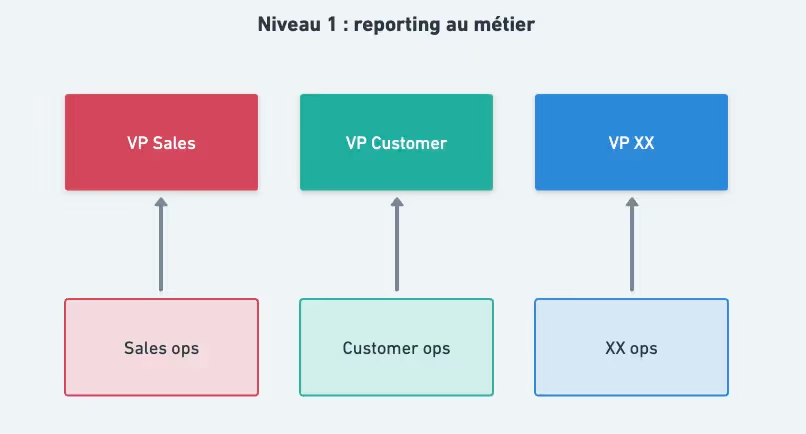
Step 2: Partial centralization of Ops teams
When businesses want to centralize their teams Ops without directly linking them to business departments, we often observe two models: reporting to a corporate C-Level, such as the CFO, or to the Growth department.
Benefits
- Creating synergies : This centralization makes it possible to pool resources, such as the establishment of a CRM team common to several departments, thus strengthening operational efficiency.
- Proximity to finance : By linking the Ops at the CFO, the team is closer to budgets and can benefit from increased financial support for its projects.
Disadvantages
- Lack of complete independence : The Ops remain a sub-function of another department, which prevents them from achieving the autonomy necessary to become a strategic pillar within the organization.
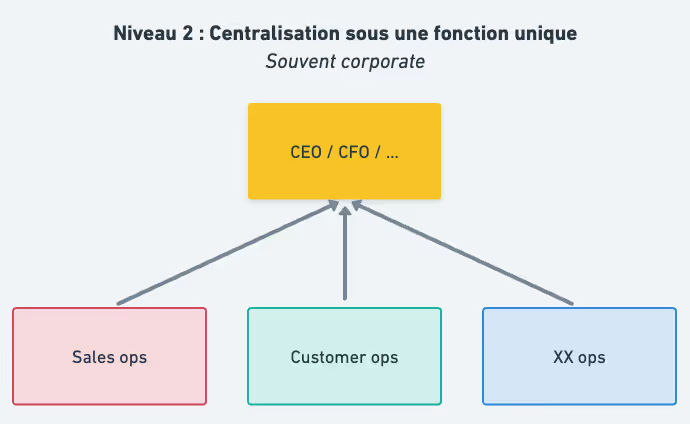
Step 3: Ops becomes an autonomous department
In this phase, theOps becomes a fully-fledged department with its own leadership at the VP or C-Level level, thus taking a seat at the executive committee table.
Benefits
- Strategic role : The Ops acquire a central role in the development and execution of business strategy. They become drivers of major organizational transformation projects.
Disadvantages
- Risk of disconnection : With this rise in power, there is a risk that the team Ops lose sight of the daily needs of the field, by focusing more on large-scale strategic projects.
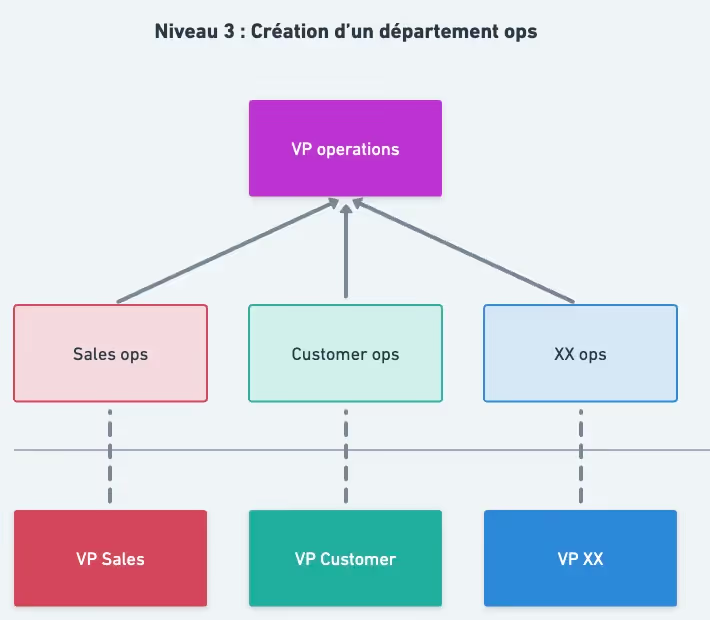
Step 4: A partial return to jobs
As the organization grows, the gap between global strategic projects and day-to-day operational needs becomes difficult for a single team to bridge. Ops centralized. Thus, part of the team remains at the central level, while another part is reintegrated into the business teams.
Benefits
- Balance between strategy and terrain : This hybrid approach makes it possible to maintain a team dedicated to strategic transformation projects, while ensuring direct and responsive monitoring of business needs.
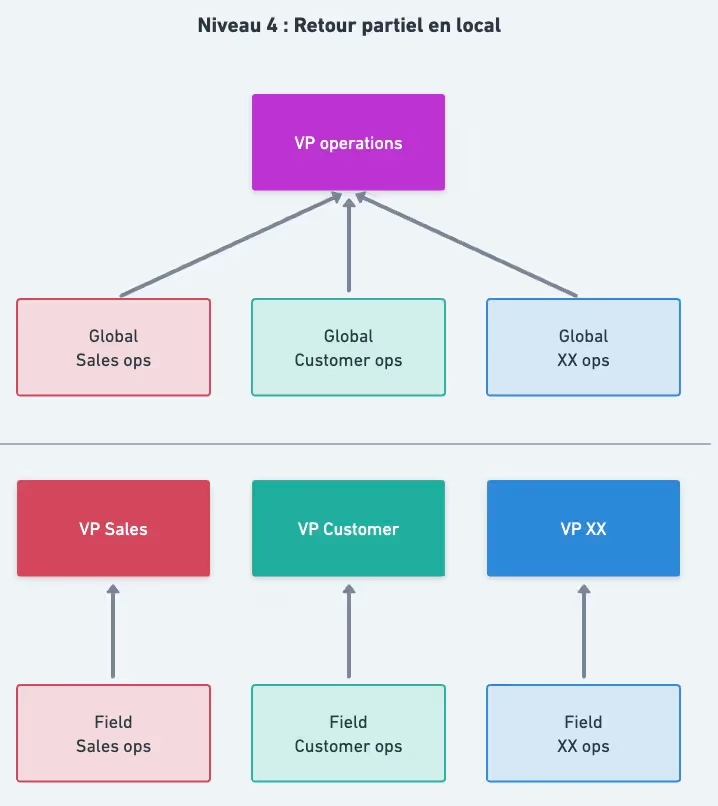
Conclusion
The teams Revenue Operations, or “ops”, play a strategic and transversal role within companies by optimizing processes, managing tools and facilitating inter-department collaboration. Their mission is clear: to improve operational efficiency to allow business teams to focus on their core mission and achieve their goals. True architects behind the scenes, the ops are the guarantors of the fluidity of internal operations, creating the conditions necessary to support the growth and agility of modern organizations. Their contribution is now becoming indispensable for businesses looking to successfully navigate a constantly changing environment.



Quelques chiffres









.avif)